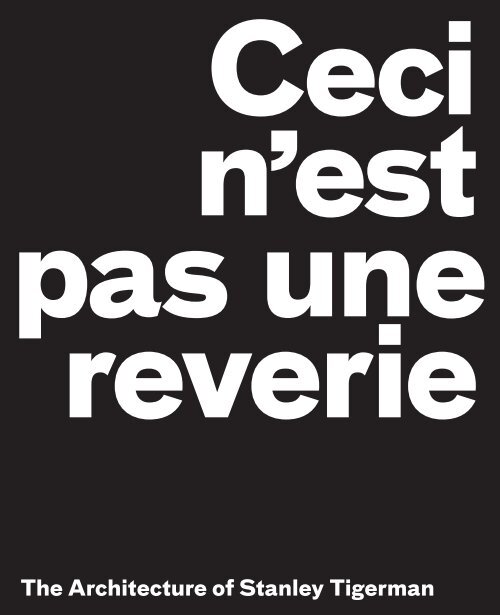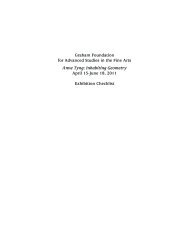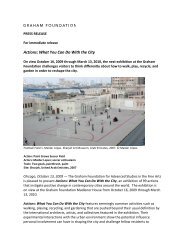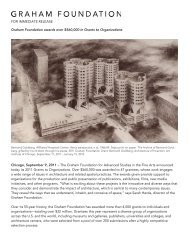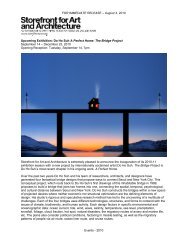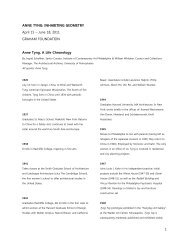Nine Clouds of Architecture, Essay by Emmanuel Petit - Graham ...
Nine Clouds of Architecture, Essay by Emmanuel Petit - Graham ...
Nine Clouds of Architecture, Essay by Emmanuel Petit - Graham ...
Create successful ePaper yourself
Turn your PDF publications into a flip-book with our unique Google optimized e-Paper software.
Ceci<br />
n’est<br />
pas une<br />
reverie<br />
The <strong>Architecture</strong> <strong>of</strong> Stanley Tigerman
Stanley Tigerman with Instant City model, photograph <strong>by</strong> Balthazar Korab, 8 x 10”, 1966
<strong>Nine</strong> <strong>Clouds</strong> <strong>of</strong> <strong>Architecture</strong><br />
<strong>Emmanuel</strong> <strong>Petit</strong>, curator<br />
Stanley Tigerman (b. 1930) combines the nonchalant<br />
imaginativeness <strong>of</strong> a dreamer with the pragmatic focus<br />
<strong>of</strong> a realist. His belief in the pedagogical dimension <strong>of</strong><br />
the “project” <strong>of</strong> architecture accounts for the versatility<br />
<strong>of</strong> his work, which <strong>by</strong> far exceeds that <strong>of</strong> routine<br />
pr<strong>of</strong>essional production. As a writer, Tigerman is a<br />
passionate polemicist; as an artist, an aphorist. One <strong>of</strong><br />
Tigerman’s most idiosyncratic and important contributions<br />
to the architectural discussion is his relentless<br />
insistence on the architect's ethic to interpret his or her<br />
physical, cultural, and sociological habitat. Tigerman<br />
is one <strong>of</strong> the few architects <strong>of</strong> his generation who<br />
has managed, in their built work, to retain the candid<br />
critical charge <strong>of</strong> speculative sketches and writings.<br />
Throughout Tigerman's work, aesthetic demand goes<br />
face to face with ethical stipulation; to argue for the<br />
necessity <strong>of</strong> a dialogue between the two is Tigerman’s<br />
most insistent thesis.<br />
While committed to the history <strong>of</strong> the discipline,<br />
Tigerman is never shy about expressing his conviction<br />
that architecture needs to allow emergent voices<br />
to supplement its hegemonic traditions. In Chicago,<br />
his hometown, he has acknowledged the historical<br />
importance <strong>of</strong> Louis Sullivan, Frank Lloyd Wright,<br />
Daniel Burnham and, importantly, Ludwig Mies van<br />
der Rohe, among others. However, at numerous occasions<br />
he has made himself a strong advocate <strong>of</strong> new<br />
generations <strong>of</strong> architects with alternative approaches<br />
and ideas.<br />
Tigerman has kept his work fresh <strong>by</strong> not allowing<br />
the fixation on a particular “style.” He made this apparent<br />
in his book Versus (1982), in which he classified<br />
his personal creative periods, and labeled them<br />
Mies-Influenced, Brutalist, Megastructural, Socially<br />
Conscious, Manipulated Modernist, Surrealist,<br />
Absurdist, Historically Allusive, and Post-Modernist,<br />
respectively. When he established himself as an architect<br />
and thinker in Chicago, Mies’s legacy was very<br />
much alive; however, the city seemed ideologically<br />
monolithic and its architecture dominated <strong>by</strong> large<br />
corporate firms. The influence <strong>of</strong> Mies on Tigerman,<br />
and Paul Rudolph's tutelage both at Yale and in<br />
Rudolph’s <strong>of</strong>fice cannot be overstated in the early<br />
years, when Tigerman admitted in his usual ironic and<br />
self-deprecatory rhetoric that he had “jumped aboard<br />
the van der Rohe bandwagon” 1 to compensate for his<br />
lack <strong>of</strong> architectural credentials. His designs <strong>of</strong> the<br />
Five Polytechnic Institutes in Bangladesh, on which<br />
he collaborated with his Yale classmate Muzharul<br />
Islam ('61) while Rudolph also worked in Bangladesh,<br />
stem from this time. 2<br />
When Mies died in 1969, at the time <strong>of</strong> rising social<br />
and political discontent in the Western world,<br />
Tigerman’s intellectual concerns shifted, taking<br />
expression in what he came to alternatively call his<br />
“post-Holocaust” and “post-Vietnam” 3 architecture.<br />
His work now became openly allegorical and revolved<br />
around the question <strong>of</strong> meaning. While Robert Venturi<br />
had opened the door to this type <strong>of</strong> semiological and<br />
symbolic investigation in architecture in the mid– to<br />
late 1960s, Tigerman’s specific version was very different:<br />
in contrast to Venturi’s formalist interpretation<br />
<strong>of</strong> it, Tigerman’s was existentialist in character.<br />
He became interested in theories <strong>of</strong> existentialism in<br />
literature, philosophy, theology and read Dostoevsky,<br />
Kierkegaard, Nietzsche, Kafka, and Beckett. This pursuit<br />
helped him define architecture as a discipline concerned<br />
with the conditions <strong>of</strong> human existence, moral<br />
value and human identity. It further revealed that he<br />
was part <strong>of</strong> a generation <strong>of</strong> architects, for whom the<br />
memory <strong>of</strong> World War II had a defining influence on<br />
their thinking in architecture: among them, Aldo Rossi<br />
found in metaphysical poetry and in de Chirico paradigms<br />
for “archetypal” forms <strong>of</strong> human remembrance<br />
in the architecture <strong>of</strong> the city; Peter Eisenman invoked<br />
Sartre and Camus to come to terms with the lost concomitance<br />
<strong>of</strong> form and meaning after the war; Arata<br />
Isozaki borrowed from Kitaro Nishida’s philosophy <strong>of</strong><br />
“nothingness” to move beyond the naïve utopianism<br />
<strong>of</strong> Japanese modernism; and Tigerman’s friend John<br />
Hejduk reinterpreted the motifs <strong>of</strong> Greek tragedy to<br />
propose an architecture “<strong>of</strong> pessimism.” Unlike most<br />
<strong>of</strong> these architects’ approaches, Tigerman’s existentialism<br />
had religious connotations, and bore traces <strong>of</strong><br />
his Jewish self-consciousness: the impossibility <strong>of</strong> the<br />
synthetic oneness <strong>of</strong> form was the recurring and cardinal<br />
idea that would culminate in Tigerman’s assertion<br />
that “postmodernism is a Jewish phenomenon.” 4<br />
Tigerman’s talent as a draftsman is essential to understanding<br />
the character <strong>of</strong> his architecture: cartoons<br />
and sketches have been constant companions on his<br />
architectural journey. His project drawings <strong>of</strong>ten reflect<br />
the travel memories <strong>of</strong> urban places and architectural<br />
precedents, which he has relentlessly recorded<br />
in his sketches. Some <strong>of</strong> the drawings are part <strong>of</strong>
larger series <strong>of</strong> illustrated themes—like, for instance,<br />
“energy” and “power”; they reveal that Tigerman<br />
sees architecture as a medium to interpret the world<br />
surrounding him—rather than the mere “art <strong>of</strong> building.”<br />
The so-called Architoons then are his most<br />
unique and idiosyncratic mode <strong>of</strong> expression: they<br />
are humorous and lively depictions <strong>of</strong> little “soldiers”<br />
interacting with an architectural universe. A number<br />
<strong>of</strong> Tigerman’s “real” projects derive their comic spirit<br />
from these drawings; the mode <strong>of</strong> expression <strong>of</strong> the<br />
Architoons is also part <strong>of</strong> a common interest <strong>of</strong> many<br />
<strong>of</strong> his contemporaries: Tom Bee<strong>by</strong>, Hans Hollein,<br />
Charles Moore, Robert A.M. Stern, among many, utilized<br />
humor as a way to reenergize the discipline after<br />
the modernist will to abstraction had purged it <strong>of</strong> all<br />
“external” content.<br />
No question has been more stimulating to Tigerman<br />
than the relationship (and disjunction) between “thinking”<br />
in architecture and its socio-physical reality. To<br />
him, this double reality is deeply engrained in the<br />
cultural self-identification <strong>of</strong> the diverse ethnicity <strong>of</strong><br />
the West. Fueled <strong>by</strong> his interest in the distinct social<br />
traditions <strong>of</strong> various religious and cultural groups, especially<br />
Hebrew culture, Tigerman discovered a cleft<br />
between two versions <strong>of</strong> the original hut: on the one<br />
hand, the ancient Greeks had inaugurated the hegemonic<br />
paradigm <strong>of</strong> the physically present, geometrically<br />
defined temple, built for eternity—the Parthenon<br />
claiming its right to exist against nature. On the other<br />
hand, Tigerman refers to the First Temple <strong>of</strong> the Jews:<br />
unlike the Parthenon, whose heavy stones prevail as<br />
a verifiable Classical source, the vanished Temple<br />
<strong>of</strong> Solomon can only be recalled through la<strong>by</strong>rinths<br />
<strong>of</strong> archeological and ethnological memory. Whereas<br />
the Hellenic temple is actual, the Hebrew edifice is<br />
present as absence—it only exists as a multiplicity <strong>of</strong><br />
narrations and exegeses. It associates more with a temporary<br />
tent or scaffolding than a solid building.<br />
Tigerman maintains that neither <strong>of</strong> these temples<br />
could exist in a “pure” state or in isolation, as an autonomous<br />
aesthetic "thing." Indeed, if one took seriously<br />
the ethical grounds <strong>of</strong> architecture as Tigerman<br />
does, each one <strong>of</strong> these conceptual models would have<br />
to acknowledge the existence <strong>of</strong> the other, and jettison<br />
a longing for a stabilizing (Hegelian) synthesis between<br />
them. With the intellectual resources <strong>of</strong> ethical<br />
and dialogical philosophers, from Søren Kierkegaard<br />
to Martin Buber and <strong>Emmanuel</strong> Levinas, Tigerman<br />
sees dynamic dialectic as the source <strong>of</strong> architecture’s<br />
contamination and, at the same time, <strong>of</strong> its vitality. In<br />
his architectural oeuvre, the dialectic has manifested<br />
itself in different ways and in diverse media—from the<br />
titles <strong>of</strong> his 1982 and 1988 books, respectively Versus<br />
and <strong>Architecture</strong> <strong>of</strong> Exile, to the binary compositions<br />
<strong>of</strong> sketches and design objects—and to the polar organization<br />
<strong>of</strong> many <strong>of</strong> his architectural projects such<br />
as the Little House in the <strong>Clouds</strong> (1976), the Daisy<br />
House in Porter, Indiana (1976–78), the Urban Villa<br />
in Tegeler Hafen (1984–88), the D.O.M. Corporate<br />
Headquarters in Cologne, Germany (1980), and the<br />
Berlin Wall Project (2000).<br />
The most polemical expression <strong>of</strong> the idea <strong>of</strong><br />
dialectics in architecture is Tigerman’s now famous<br />
1978 collage, “The Titanic,” where he floats Mies<br />
van der Rohe’s Crown Hall at the Illinois Institute <strong>of</strong><br />
Technology precariously in Lake Michigan against a<br />
background <strong>of</strong> clouds, acting as symbol <strong>of</strong> a necessary<br />
supplement to all creative and humane architecture:<br />
arationality and ambivalence. To Tigerman, Mies was<br />
the modern heir <strong>of</strong> the Greek ideology <strong>of</strong> hierarchy<br />
and “presence,” which Mies inherited from Karl F.<br />
Schinkel. Tigerman’s collage suggested that Mies’s<br />
rigid geometry should be seen against its “other”—<br />
the fluid and indeterminate formal logic <strong>of</strong> waves and<br />
clouds. Unlike the Parthenon, which was conceived<br />
as a crowning event, erected in stark contrast to the<br />
natural landscape, Mies’s “temple <strong>of</strong> architecture,”<br />
reinterpreted as “The Titanic,” appeared in egalitarian<br />
dialogue with the ephemerality <strong>of</strong> nature. With his polemical<br />
collage, Tigerman expressed an architectural<br />
discourse that reflected a personal and autobiographical<br />
desire to liberate himself from the dictates <strong>of</strong> the<br />
corporate culture <strong>of</strong> Skidmore, Owings & Merrill, C.F.<br />
Murphy, and others. Tigerman demanded that the baton<br />
be passed to a (then) young generation <strong>of</strong> Chicago<br />
architects, who felt a Bloomian “anxiety <strong>of</strong> influence”<br />
with respect to their Modern antecedents. In 1976,<br />
Tigerman formalized his resistance <strong>by</strong> inaugurating a<br />
group <strong>of</strong> freethinkers, The Chicago Seven, to penetrate<br />
a discourse which they perceived as both monolithic<br />
and lethargic.<br />
Tigerman’s “Little House in the <strong>Clouds</strong>” from 1976<br />
became another architectural manifesto <strong>of</strong> the idea<br />
<strong>of</strong> endless dialectic. Both the brief and the title <strong>of</strong> the<br />
house suggested that the proposal was grounded in<br />
an “alternative” logic, to shun the straight rationalism<br />
<strong>of</strong> Chicago’s pragmatist tradition. In the face <strong>of</strong>
Kingdom <strong>of</strong> Atlantis, axonometric, ink on vellum, 36 x 24.25", 1976-82<br />
architects such as Holabird, Burnham, Jenney, and<br />
Root, Tigerman exploited the implications <strong>of</strong> the literary<br />
motif <strong>of</strong> “clouds” in architecture, both visually<br />
and philosophically. On the visual level, he painted<br />
the ceiling <strong>of</strong> the Little House with the trompe l’œil<br />
<strong>of</strong> a cloudy sky as an implicit reference to René<br />
Magritte’s surrealist paintings —“Human Condition”<br />
(1935), the “Call <strong>of</strong> the Summits” (1942), “Personal<br />
Values” (1952), or the painted murals “The Enchanted<br />
Realm” <strong>of</strong> clouds in the grand salon <strong>of</strong> the Casino in<br />
Knokke-Heist / Le Zoute (1953). For Tigerman, as<br />
for Magritte, the illusionistic visual device <strong>of</strong> painted<br />
clouds suggested the paradoxical relationship between<br />
the enclosed and finite space <strong>of</strong> architecture and its<br />
“exterior” as the infinite space <strong>of</strong> the imagination. For<br />
Tigerman and Magritte, art and architecture can only<br />
signify through interpretation, association and allusion,<br />
yet cannot inherently embody ideas. In order to<br />
self-consciously communicate this restriction, both<br />
artists have <strong>of</strong>ten reverted to irony.<br />
The motif <strong>of</strong> Tigerman’s mural goes back to its literary<br />
use in the Aristophanic comedy, The <strong>Clouds</strong>. The<br />
play not only lampooned the sophist tendencies <strong>of</strong><br />
Ancient Athens around Socrates, but also ridiculed a<br />
number <strong>of</strong> initiation rites into the intellectual life <strong>of</strong> a<br />
public person. The <strong>Clouds</strong> was an irreverent satire <strong>of</strong><br />
pompous academia and an example <strong>of</strong> self-referential<br />
literature; indeed, towards the middle <strong>of</strong> the play, the<br />
playwright himself took the stage and chastised the<br />
audience for their lack <strong>of</strong> humor. The satiric thrust<br />
was made explicit <strong>by</strong> the presence <strong>of</strong> the accompanying<br />
“Chorus <strong>of</strong> <strong>Clouds</strong>,” which stood for the divine
presence and consisted <strong>of</strong> female dancers; it was<br />
quickly revealed, ironically, that The <strong>Clouds</strong> indulged<br />
in the seductive power <strong>of</strong> words and the corruptive potential<br />
<strong>of</strong> language, but never in any “clear” communication.<br />
Tigerman was attracted to the anti-positivist<br />
connotations <strong>of</strong> the symbol <strong>of</strong> the clouds, representing<br />
his antagonism <strong>of</strong> the monumental institution and sterile<br />
aesthetics <strong>of</strong> modern architecture without pinning<br />
down his own principles, there<strong>by</strong> avoiding a possible<br />
trap <strong>of</strong> exchanging one type <strong>of</strong> monumentalism with<br />
another. The “Little House in the <strong>Clouds</strong>” proposed an<br />
architecture as formless clouds.<br />
The exhibition title “Ceci n’est pas une rêverie,”<br />
borrows from Magritte’s painting “Ceci n’est pas<br />
une pipe” and thus denotes the paradoxical dialectic<br />
between “idea” and “representation,” between word<br />
and painting. The design <strong>of</strong> the exhibition itself further<br />
capitalizes on the motif <strong>of</strong> clouds with the architecture<br />
gallery converted into the index <strong>of</strong> an oneiric, “other,”<br />
more fluid and ephemeral architecture. To this end,<br />
nine thematic “clouds” are situated under a firmament<br />
<strong>of</strong> hundreds <strong>of</strong> Tigerman’s projected sketches. Each<br />
cloud regroups paintings, cartoons, drawings, design<br />
objects, and models surrounding particular leitmotifs<br />
<strong>of</strong> Tigerman’s architecture.<br />
The Utopia Cloud is comprised <strong>of</strong> hypothetical<br />
projects from the late 1960s to the early 1980s. “Urban<br />
Matrix” (1967–68), “Instant Football” (1971–72), and<br />
“Kingdom <strong>of</strong> Atlantis” (1976–82) are conceived on a<br />
grand scale, and incorporate mixed programs within<br />
large glass and steel frameworks. Confidence in the<br />
power <strong>of</strong> architecture and trust in the structuring logic<br />
<strong>of</strong> geometry in these projects was preceded <strong>by</strong> a series<br />
<strong>of</strong> seventy-eight abstract compositional experiments,<br />
the “Formal Generators <strong>of</strong> Structure” (1965–68),<br />
which served as blueprints for Tigerman’s spectrum<br />
<strong>of</strong> design activity, from master plans for ideal cities to<br />
decorative ornamentation for bed linens.<br />
Tigerman insists that architecture is fundamentally<br />
relational and allegorical. The projects in The Allegory<br />
Cloud hinge on the idea that meaning is brought<br />
to architecture “from the outside.” For the Strada<br />
Novissima at the “postmodern” 1980 Venice Biennale,<br />
Tigerman designed a façade based on the idea <strong>of</strong> the<br />
mise-en-abîme <strong>of</strong> theatrical curtains to suggest that<br />
architecture is composed <strong>of</strong> a long chain <strong>of</strong> representations<br />
without ever <strong>of</strong>fering any intrinsic being. In a<br />
built project for the Anti-Cruelty Society in Chicago<br />
(1979), Tigerman interpreted the urban animal shelter<br />
alternatively as a ‘killing machine’ and an Animal<br />
Cracker box; the design for a bathroom becomes<br />
an homage to a piece <strong>of</strong> literature, Dante’s Divine<br />
Comedy; tableware turns into a romantic tableau <strong>of</strong><br />
the relationship between nature and architecture.<br />
There is something inherently vital and optimistic in<br />
the act <strong>of</strong> architectural construction; yet, for Tigerman,<br />
a one-sided positiveness feels numb or facile, and the<br />
act must be considered in dialectic with notions <strong>of</strong><br />
finitude and death. The projects in The Death Cloud<br />
address Kierkegaard’s double theme <strong>of</strong> life and death<br />
in diverse ways: Tigerman’s Guernica museum project<br />
“for a Painting That Will Never Go There” (1981)<br />
materializes the flight line <strong>of</strong> the lethal aerial raid on<br />
the city <strong>of</strong> Guernica during the Spanish Civil War; the<br />
World Trade Center Memorial competition project<br />
(2002) and the Joel Harlib Funerary Monument (1981)<br />
thematize with architectural means the dialectic qualities<br />
<strong>of</strong> stasis (the fact <strong>of</strong> death) and dynamism (the<br />
act <strong>of</strong> memory). The “double temple” <strong>of</strong> the Illinois<br />
Holocaust Museum and Education Center (2000–09)<br />
configures a tw<strong>of</strong>old procession <strong>of</strong> descent into darkness,<br />
and ascent into light.<br />
Tigerman first came to prominence at a time, when<br />
late-Modernism tended to regurgitate the abstract<br />
forms <strong>of</strong> Modern architecture without much ideological<br />
persuasion. By the 1970s, Tigerman had set adrift<br />
the positivist certainties <strong>of</strong> architectural modernism,<br />
to which he had been exposed in his formative years.<br />
In particular, he confronted the rigidity <strong>of</strong> the Miesian<br />
grid with a more loosely defined curvilinear geometry.<br />
In the Labadie House (1976–77) in The Drift<br />
Cloud, Tigerman suspends the abstraction <strong>of</strong> Miesian<br />
Modernism and replaces it with a formal lyricism<br />
analogous to that <strong>of</strong> Hejduk; the Illinois Regional<br />
Library for the Blind & Physically Handicapped<br />
(1975–78) represents an attack on the hegemony <strong>of</strong><br />
visual culture in architecture, and quite literally introduces<br />
a tactile dimension to help blind individuals<br />
“drift” through the spaces <strong>of</strong> the library; the Kosher<br />
Kitchen for a Jewish American Princess (1977–78)<br />
uses curves as formal devices to planimetrically describe<br />
an alternative way <strong>of</strong> inhabiting the symmetrical<br />
and hierarchical spaces <strong>of</strong> the classical American<br />
house typology. These formalist strategies consciously<br />
resonated with the existentialist leitmotif <strong>of</strong> the individual<br />
“drifting” through a place and time he or she<br />
has been thrown into, and the attempt at reorientation.
Hot Dog House, Harvard, Illinois, axonometric 1, ink on Mylar, 25 x 50", 1974-75
Architoon, San Francisco 1982, Prismacolor on bond paper mounted on board, 13 x 10",1982
Architoon, San Francisco 1982, Prismacolor on bond paper mounted on board, 13 x 10",1982
Labadie House, Oakbrook, Illinois, cut-away axonometric, ink on Mylar, 32 x 80, 1976–77<br />
Tigerman uses humor as an instrument for overcoming<br />
architecture culture’s deep-seated seriousness<br />
and authoritarianism. To bring objects into durable<br />
presence in the physical world, as architecture does,<br />
presumes a conceit <strong>of</strong> righteousness that can be nuanced,<br />
or defused with humor. The projects and<br />
drawings in The Humor Cloud associate with a sense<br />
<strong>of</strong> Robin Hood-ism <strong>by</strong> considering serious subjects<br />
<strong>of</strong> architecture with wit. Tigerman’s Architoons, as<br />
well as the Daisy House (1976–78) combine tragedy<br />
and comedy. Indeed, the client for the Daisy House<br />
was a terminally ill cancer patient and the owner <strong>of</strong><br />
burlesque show venues in Chicago; the house’s plan<br />
merges the iconography <strong>of</strong> male and female genitals<br />
in Tigerman’s comic interpretation <strong>of</strong> both Claude-<br />
Nicolas Ledoux’s Oikema and <strong>of</strong> Robert Venturi’s idea<br />
<strong>of</strong> the “decorated shed.” With the BEST Home <strong>of</strong> All<br />
(1979), the drawings for Alessi (1983), the American<br />
Standard Showplace (1989), and the Tiger Tools<br />
(1988), Tigerman reinterprets utilitarian objects <strong>by</strong><br />
employing humorous semantics.<br />
To signify his architecture’s dissociation from traditional<br />
disciplinary values like synthesis, coherence,<br />
and immanence, Tigerman <strong>of</strong>ten introduces structural<br />
markers <strong>of</strong> division and duality in his projects. The<br />
Division Cloud shows that the cracks, fissures, clefts,<br />
splits, schisms, and rifts have kinetic implications for<br />
the composition and the architectural program, and<br />
<strong>of</strong>fer opportunities for a dynamic procession through<br />
structure. Tigerman has deployed the strategy at all
design scales: from a scheme for a double-linear park<br />
on either side <strong>of</strong> the Berlin Wall (2000); to the Ba'hai<br />
Archives Center in Evanston, Illinois (1976), which<br />
didactically slits the project’s spatial volume in two<br />
equal (man-made and "natural") parts; to the design<br />
<strong>of</strong> jewelry and tableware, marking even the division<br />
<strong>of</strong> a synthetic form into functional pairs like salt &<br />
pepper. The sketches for Tigerman’s books Versus and<br />
<strong>Architecture</strong> <strong>of</strong> Exile extend the idea <strong>of</strong> division into<br />
the context <strong>of</strong> architectural theory.<br />
The Identity Cloud thematizes Tigerman’s complex<br />
relationship to Mies(ianism) in Chicago, as<br />
shown in his reinterpretation <strong>of</strong> the site plan for the<br />
Graceland Cemetery (1996), where Tigerman and his<br />
partner Margaret McCurry’s common tomb aligns<br />
with an axis connecting Mies’s gravestone with Lake<br />
Michigan, and with two <strong>of</strong> Tigerman’s own projects<br />
for Chicago—the Pensacola and Boardwalk buildings<br />
(1978—81). Likewise, Tigerman’s other projects in<br />
Chicago attempt to add a layer <strong>of</strong> memory to the pragmatic<br />
”city without memory.”<br />
Tigerman considers measurement to be an essential<br />
principle <strong>of</strong> legibility in architecture, and he sees the<br />
grid as the most potent architectural tool to structure<br />
space and time in a project. Unlike Mies, with his<br />
unequivocal grids, Tigerman avails himself <strong>of</strong> multiple<br />
grid systems that dislocate the sense <strong>of</strong> stability,<br />
orientation, and hierarchy, to suggest the existence<br />
<strong>of</strong> another non-linear order in architecture. The grid<br />
systems in The (Dis)Order Cloud read like scaffolds,<br />
alluding to the impermanence and vulnerability <strong>of</strong><br />
all things and ideas; they help define architecture as<br />
the perpetual “attempt to heal an irreparable wound.”<br />
The Momochi Housing in Fukuoka, Japan (1988-89),<br />
the Park Lane Hotel Renovation in Kyoto (1990),<br />
the Urban Design Intervention in Madrid (1992), the<br />
Commonwealth Edison Energy Museum in Illinois<br />
(1987–90), and the Belgrade Apartment Building<br />
(1990–91), all hinge on the compositional dialogue<br />
between multiple, three-dimensional grids.<br />
The Yaleiana Cloud presents Tigerman’s bachelor’s<br />
(’60) and master’s (’61) theses at Yale, as well as some<br />
<strong>of</strong> his first post-graduation projects. Among them are<br />
the Chapman House in Crete, Illinois (1963), Bum’s<br />
Housing in Chicago (1966), and the Polytechnic<br />
Institutes in Bangladesh (1966–75). Paul Rudolph's<br />
and Louis Kahn’s influences as teachers are evident in<br />
these early projects—in the round window openings<br />
in the heavy masonry walls, the crenellated building<br />
outlines, and the expressive piers with service programs,<br />
as well as in his drawing techniques. A series<br />
<strong>of</strong> oil and acrylic paintings from the mid–1960s drew<br />
inspiration from Josef Albers, with whom Tigerman<br />
studied when he was at Yale; these are Tigerman’s<br />
‘op art’ experiments created through the medium <strong>of</strong><br />
geometry.<br />
“Ceci n’est pas une rêverie" exposes a fundamental<br />
irony driving the architecture <strong>of</strong> Stanley Tigerman:<br />
his architecture hovers around the most ambitious<br />
dream <strong>of</strong> humanity—to “build” the mythical Ur-home,<br />
Heaven, all the while acknowledging in his art the<br />
real contingencies and limitations <strong>of</strong> realizing such<br />
a conceit. The idea <strong>of</strong> an autonomous aesthetics is<br />
relativized <strong>by</strong> the ethical imperative that demands that<br />
architecture remains open to the capricious and heterogeneous<br />
impulses <strong>of</strong> human life. It has thus become<br />
Tigerman’s quest to resist the traditional aesthete’s<br />
credo <strong>of</strong> purging art <strong>of</strong> its disturbances, and instead to<br />
install architecture as an active participant in the volatile<br />
inspirations <strong>of</strong> humankind.<br />
1. Stanley Tigerman, Versus, an American Architect’s Alternatives<br />
(New York: Rizzoli, 1982), 15.<br />
2. Tigerman, “Thoughts About Louis Kahn,” Schlepping Through<br />
Ambivalence: <strong>Essay</strong>s on an American Architectural Condition,<br />
edited <strong>by</strong> <strong>Emmanuel</strong> <strong>Petit</strong> (New Haven: Yale University Press,<br />
2011), 130.<br />
3. Tigerman, “Schlepping Through Ambivalence: An American<br />
Architectural Condition,” (1983) Schlepping Through Ambivalence,<br />
148.<br />
4. Chapter <strong>Nine</strong> <strong>of</strong> Tigerman’s book Versus is entitled “Post-Modernism<br />
is a Jewish Movement 1976-1981.” Quoted in Philip Bess,<br />
“Beyond Irony: Biblical Religion and Architectural Renewal,” Till<br />
We Have Built Jerusalem: <strong>Architecture</strong>, Urbanism, and the Sacred<br />
(Wilmington: ISI Books, 2006), 79. Bess sees Tigerman’s statement<br />
as pro<strong>of</strong> “…that contemporary architects [were] once again<br />
confronting a “crisis <strong>of</strong> meaning” in architecture.”


